17 February, 2002
THE MIGHTY KRILL!!!
Krill is an important part of the Antarctic food web. The
species that is most abundant here is Euphausia superba. Krill eat
phytoplankton. Other animals eat the krill.
This shrimp-like animal is sometimes called a "keystone" animal. If you
look at an arch made of stones, you will see a wedge-shaped piece of stone
in the center at the top of the arch. This stone, called the keystone, is
considered to hold all the other pieces in place. In the same way, krill
have an effect on the other animals and many of the plants of the Antarctic
marine ecosystem.
So, scientists study krill. They want to know how many krill are in the
area, what size they are, how old they are, how healthy they are, what they
are eating, and how fast they are growing. At times, krill can be found
swimming together in large swarms, or aggregations. These swarms can be
thousands of meters wide. In the wintertime, krill also can be found on the
lower surface of the sea ice. These groups of krill may contain 30,000
krill per cubic meter, according to divers who estimate their numbers.
Dr. Robin Ross is a scientist who has studied krill for many years. Dr. Ross
says that krill move 200 km in a seasonal migration pattern. They can move
against a current on the continental shelf, but they can't move against jets
of currents. Because krill can move, this means they have the ability to
have behavior. So, Robin Ross studies where the krill are found (their
distribution) as a part of the Palmer LTER cruise. This is done every
January in the offshore waters of the Antarctic Peninsula.
The Palmer LTER krill group also looks at krill in the waters right around
Palmer Station. The scientists go out in their Zodiac, "Low Rider" two
times a week to follow a transect. They use an acoustic instrument (like a
fish finder) to record data about where the krill are. The scientists take
a laptop computer on board the Zodiac in order to do this!
In the summer, the scientists collect krill in a net. They use the krill to
do experiments measuring the growth of krill. In the winter, the divers
collect the krill under the ice for the experiments.

Heidi Geisz is a field biologist with the seabird group. She is measuring krill in a winter diet sample from an Adelie penguin.
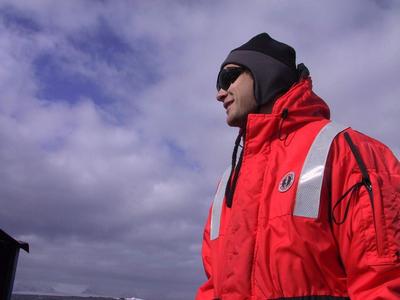
Michael Caldwell is one of the krill searchers. He is wearing the float coat and Extreme Weather Clothing that we have been issued for use in Antarctica.

The krill had been frozen after collection during the winter. Heidi Geisz is now measuring them. This work will give her some information about the diets of penguins.
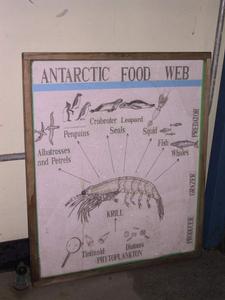
This poster shows all the other animals that eat krill. This poster is not drawn to scale! Krill are not this big. The other animals are not drawn to their relative size, either!
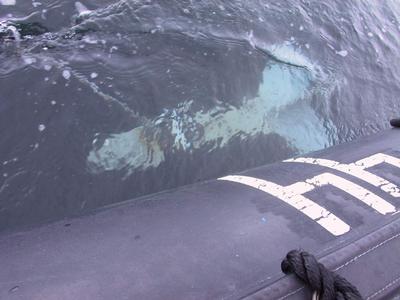
Kermit the transponder going below the surface of the water. You can see the side of Low Rider (#44) in this photo, to give you an idea of Kermit's size.
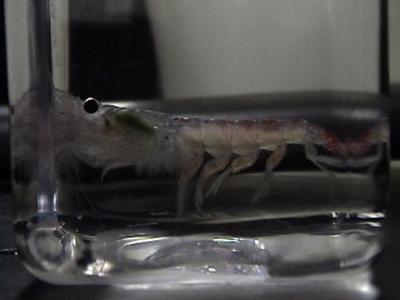
This krill, Euphausia superba, eats the phytoplankton in the water. In turn, it is eaten by penguins, other seabirds, seals, and whales.
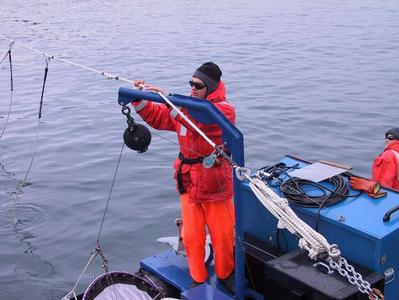
As Stephanie Oakes backs out Low Rider from her berth, Michael Caldwell makes sure that the davit and winch pass under the stern lines.
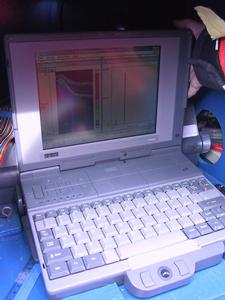
This is an image that appeared on the computer screen while we were doing the transect. The color graphs show the ocean bottom and the presence of phytoplankton, krill, and other things.
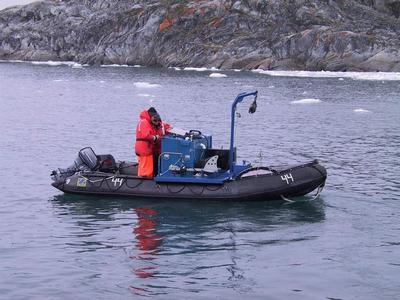
Michael and Stephanie do a final instrument check as they leave Hero Inlet.
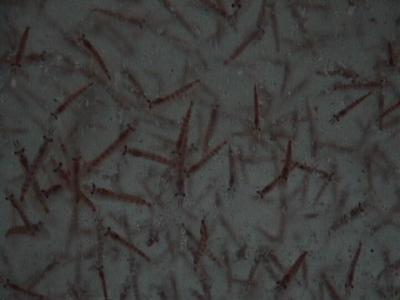
Krill swim in large groups, or aggregations. Adult krill measure 30-60 mm, measured from the top of the rostrum to the end of the usopods.
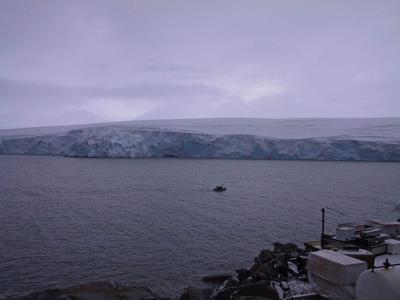
Stephanie and Michael have arrived at Station A. They will turn around and do the first transect out to Station E.
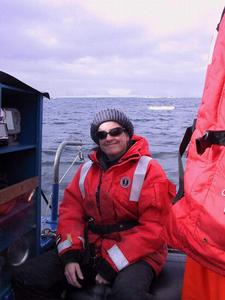
Stephanie Oakes uses Kermit the Transponder to look for krill.
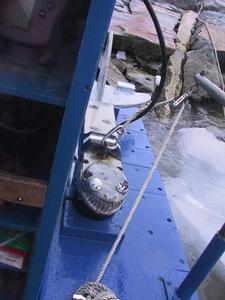
Kermit the Transponder on the Zodiac, waiting to be sent overboard!
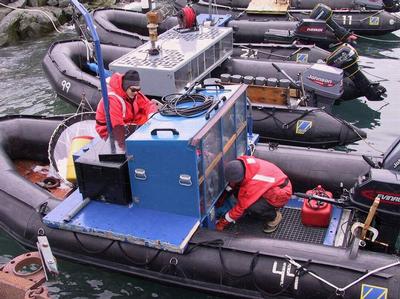
This photo gives you a good idea why the Zodiac is nicknamed "Low Rider". Look at this clever arrangement of all the instruments! The equipment is heavy. So is the box it sits in during the transect. The phytoplankton Zodiac is in the background.
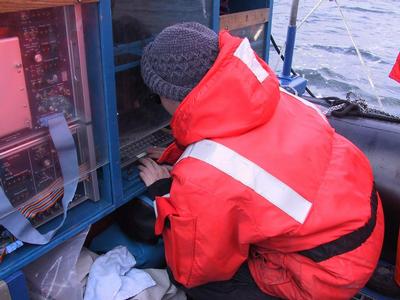
Stephanie Oakes checks the computer display to see what might be in the water below us!
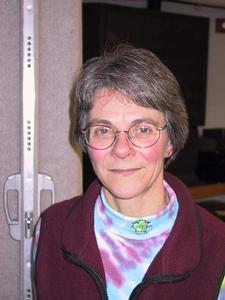
Dr. Robin Ross is a Principal Investigator on the Palmer LTER project, as is Dr. Langdon Quetin. Robin Ross was Chief Scientist on the Palmer LTER January cruise, aboard the LM Gould. This cruise followed the offshore grid of the Palmer LTER.
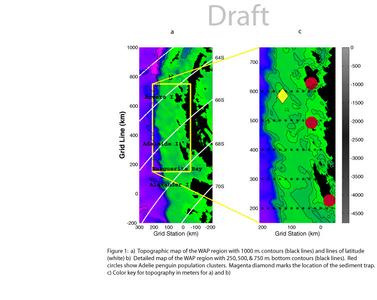
This is the grid for the Palmer LTER offshore cruise each January. The area covered in the grid is west of the Antarctic Peninsula. It goes from north of Anvers Island to Marguerite Bay. There are ten transect lines perpendicular to the coast of the Antarctic Peninsula. The lines are 100 km apart. Each line has standard sampling stations 20 km apart on the line. During the LTER cruise each summer, measurements are taken at all the stations along transect lines 200 through 600. These graphs are courtesy of Dr. Robin Ross. Here's the math: at how many stations do the scientists take measurements and water samples? What is the area of this sampling grid, in square kilometers?

Michael Caldwell is ready to go out for many hours of searching for krill!
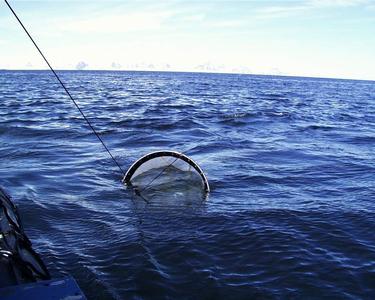
The one-meter ring net in the water. Photo courtesy of Stephanie Oakes.

The team also goes out to collect krill for growth experiments. Christopher Holmes is getting ready to deploy the net. Photo courtesy of Stephanie Oakes.
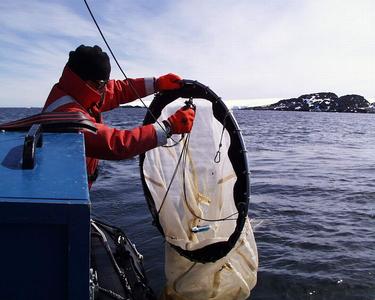
This image gives you a great view of Christopher Holmes and the krill net. Photo courtesy of Stephanie Oakes.
Contact the TEA in the field at
.
If you cannot connect through your browser, copy the
TEA's e-mail address in the "To:" line of
your favorite e-mail package.
|
